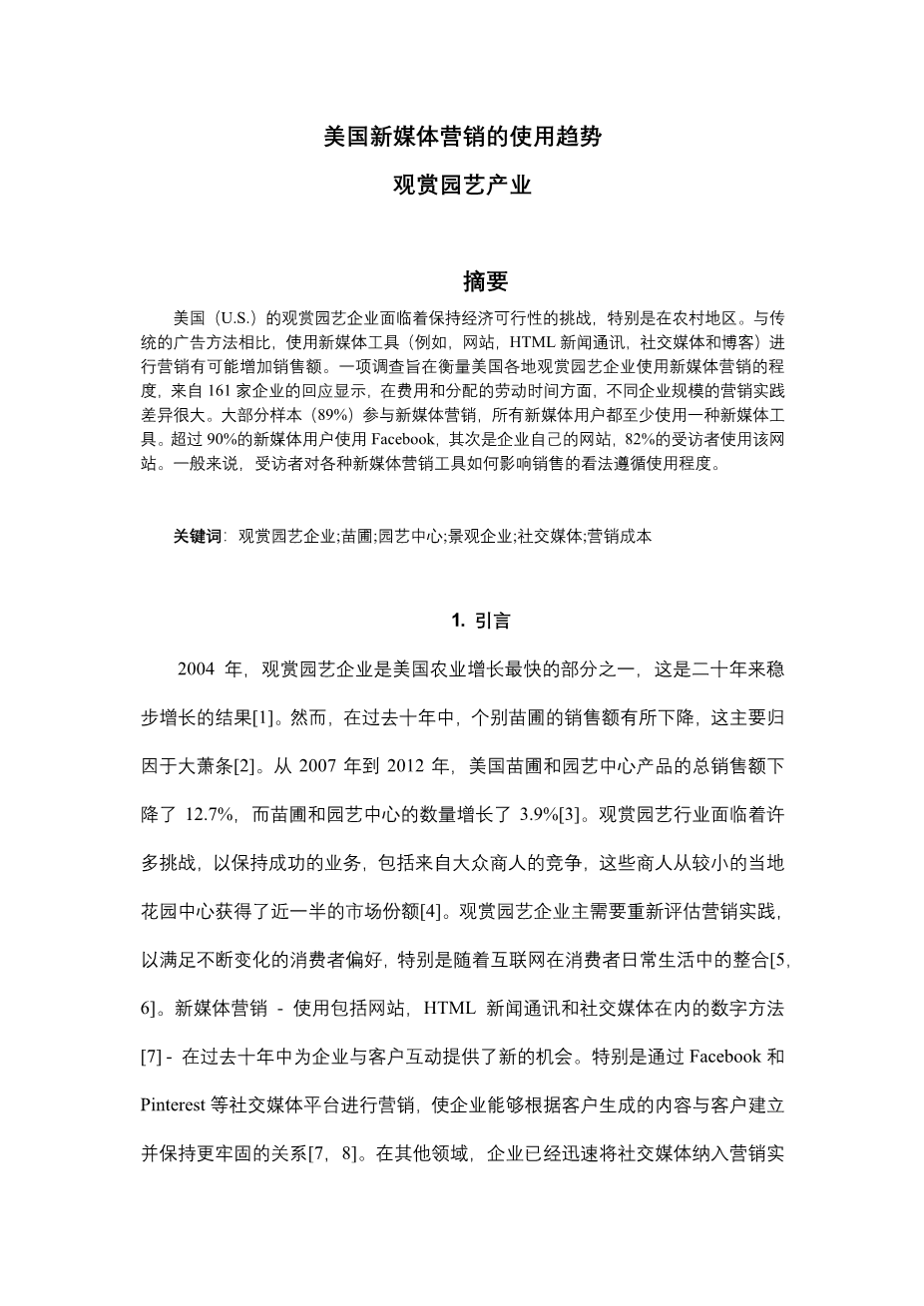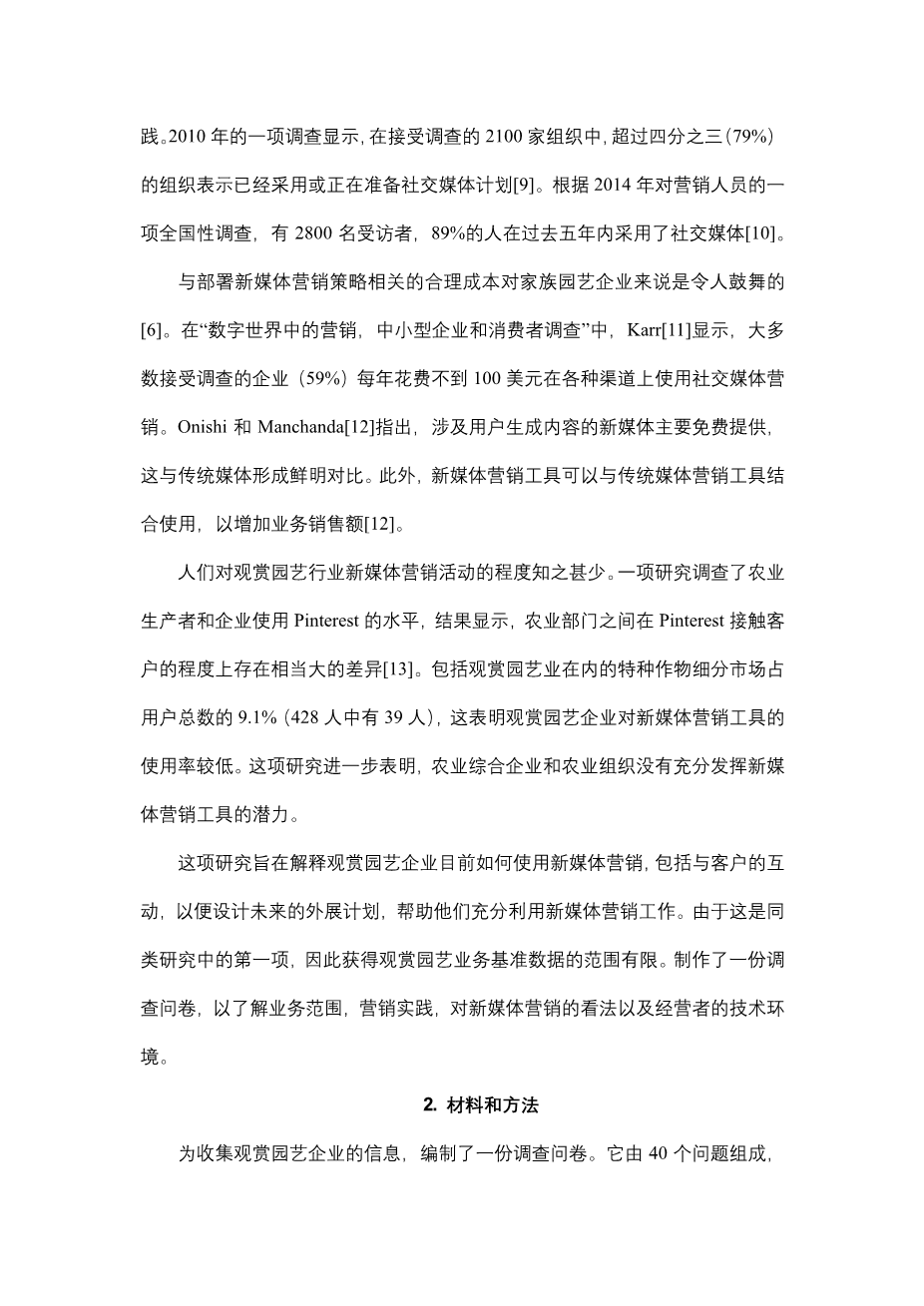Trends in the Use of New-Media Marketing in U.S.
Ornamental Horticulture Industries
Abstract
Ornamental horticulture businesses in the United States (U.S.) face challenges to stay economically viable, particularly in rural areas. Marketing with new-media tools (e.g., websites, HTML newsletters, social media, and blogs) has the potential to increase sales over traditional methods of advertising. A survey was conducted to gauge the extent of the use of new-media marketing by ornamental horticulture businesses across the U.S. Responses from 161 businesses showed that marketing practices varied widely across business size in terms of expenses and the labor hours allocated. A majority of the sample (89%) were involved in new-media marketing, and all new-media users made use of at least one new-media tool. Facebook was used by more than 90% of new-media users, followed by the businessrsquo; own website, which was used by 82% of respondents. Respondentsrsquo; perception of how various new-media marketing tools affected sales followed the extent of use, in general.
Keywords: ornamental horticulture businesses; nurseries; garden centers; landscape businesses; social media; marketing costs
1. Introduction
Ornamental horticulture businesses ranked among the fastest growing segments of U.S. agriculture in 2004, as a result of two decades of steady growth [1]. However, sales by individual nurseries have decreased over the last decade, mainly attributed to the Great Recession [2]. From 2007 to 2012, total sales of U.S. nursery and garden center products shrunk by 12.7%, whereas the number of nurseries and garden centers increased by 3.9% [3]. The ornamental horticulture industry is faced with numerous challenges to maintain successful businesses, including competition from mass merchants, which have acquired almost half the market share from smaller, local garden centers [4]. Ornamental horticulture business owners need to reevaluate marketing practices to meet changing consumer preferences, especially with the integration of the internet in the everyday lives of consumers [5,6]. New-media marketing—using digital methods including websites, HTML newsletters, and social media [7]—has provided new opportunities in the last decade for businesses to engage with customers. Marketing through social-media platforms such as Facebook and Pinterest, in particular, has allowed businesses to build and maintain stronger relationships with clientele based on customer-generated content [7,8]. In other sectors, businesses have incorporated social media into marketing practices at a rapid pace. A 2010 survey showed more than three-quarters (79%) of the 2100 organizations surveyed reported having adopted, or were preparing, social-media initiatives [9]. According to a 2014 national survey of marketers, with 2800 respondents, 89% had adopted social media within the last five years [10].
The reasonable costs associated with deploying new-media marketing strategies are encouraging to family-owned horticulture businesses [6]. In the Marketing in a Digital World, Small- and Medium-Sized Business and Consumer Survey, Karr [11] showed that a majority of businesses surveyed (59%) spent less than $100 per year to use social-media marketing on various channels. Onishi and Manchanda [12] noted new media, involving user-generated content, are primarily available for free, which is in contrast to traditional media. Moreover, new-media marketing tools can be used in conjunction with traditional-media marketing tools to increase business sales [12].
Little is known about the extent of new-media marketing activities in ornamental horticulture industries. One study, examining the level of Pinterest use by agricultural producers and businesses, showed considerable differences, between agricultural segments, in the degree of Pinterest use to reach customers [13]. The specialty crop segment, which includes ornamental horticulture industries, accounted for 9.1% (39 out of 428) of users, suggesting low use of new-media marketing tools by ornamental horticulture businesses. This study further indicated that agribusinesses and agricultural organizations were not using new-media marketing tools to their full potential.
This study aimed to explain how ornamental horticulture businesses are currently using new-media marketing, including engagement with customers, so that future outreach programs can be designed to help them make the most of new-media marketing efforts. Since this is the first study of its kind, it is limited in scope to get benchmark data on ornamental horticulture businesses. A questionnaire was developed to understand the scope of business, marketing practices, perceptions of new-media marketing, and the technological environment of business operators.
2. Materials and Methods
A questionnaire was developed to collect information from ornamental horticulture businesses. It consisted of 40 questions pertaining to businessesrsquo; online new-media marketing practices (we used the term “online” in the questionnaire, which was likely more familiar to the respondents than “new media,” but we use the terms interchangeably), including their relationships with customers. Questions were formulated around four factors: (1) Business characteristics, (2) overall marketing practices, (3) online marketing practices, and (4) respondent demographics. The questionnaire was described in the introductory email as covering business characteristics and marketing practices, requesting respondents to collaborate with colleagues, if needed, to complete the questionnaire.
The questionnaire was designed to account for three types of respondents: Those not using any new-media marketing; those using some new-media marketing, but not social-media marketing; and those using new- and social-media ma
剩余内容已隐藏,支付完成后下载完整资料


英语译文共 14 页,剩余内容已隐藏,支付完成后下载完整资料
资料编号:[603122],资料为PDF文档或Word文档,PDF文档可免费转换为Word
课题毕业论文、外文翻译、任务书、文献综述、开题报告、程序设计、图纸设计等资料可联系客服协助查找。


